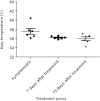Anopheles darlingi (Diptera: Culicidae) displays increased attractiveness to infected individuals with Plasmodium vivax gametocytes
- PMID: 24885914
- PMCID: PMC4049440
- DOI: 10.1186/1756-3305-7-251
Anopheles darlingi (Diptera: Culicidae) displays increased attractiveness to infected individuals with Plasmodium vivax gametocytes
Abstract
Background: Most hematophagous insects use host odours as chemical cues. The odour components, some physiological parameters and host attractiveness are affected by several conditions, including infection by parasites, e.g., plasmodia and, therefore, change the epidemiological scenario. This study evaluated the attractiveness of individuals with vivax malaria before, during (7 days) and after treatment (14 days) with specific antimalarial drugs.
Findings: Mosquito attractiveness to vivax-infected patients was assessed using a vertical olfactometer using the foot as a source of body odour. The ratio of Anopheles darlingi mosquitoes in the lower chamber of the olfactometer was used to calculate the attractiveness, and patient temperature was measured using a digital thermometer. An increased attractiveness was found only in patients bearing vivax gametocytes during the first experiment (early infection) (P<0.001). Patients in the first experiment tended to have a higher body temperature, but grouping patients into fever and non-fever resulted in a higher attractiveness only in the fever group of gametocyte carriers, suggesting a synergistic effect of temperature and gametocytes in the host attractiveness to A. darlingi.
Conclusions: Gametocyte presence and fever in vivax malaria patients increased short distance host attractiveness to An. darlingi.
Figures



Similar articles
-
Similar trends of susceptibility in Anopheles arabiensis and Anopheles pharoensis to Plasmodium vivax infection in Ethiopia.Parasit Vectors. 2016 Oct 18;9(1):552. doi: 10.1186/s13071-016-1839-0. Parasit Vectors. 2016. PMID: 27756355 Free PMC article.
-
Transmission-blocking activity of antimalarials for Plasmodium vivax malaria in Anopheles darlingi.PLoS Negl Trop Dis. 2023 Jun 16;17(6):e0011425. doi: 10.1371/journal.pntd.0011425. eCollection 2023 Jun. PLoS Negl Trop Dis. 2023. PMID: 37327209 Free PMC article.
-
Experimental infection of the neotropical malaria vector Anopheles darlingi by human patient-derived Plasmodium vivax in the Peruvian Amazon.Am J Trop Med Hyg. 2006 Oct;75(4):610-6. Am J Trop Med Hyg. 2006. PMID: 17038681 Free PMC article.
-
Interactions of human malaria parasites, Plasmodium vivax and P.falciparum, with the midgut of Anopheles mosquitoes.Med Vet Entomol. 1997 Jul;11(3):290-6. doi: 10.1111/j.1365-2915.1997.tb00409.x. Med Vet Entomol. 1997. PMID: 9330262 Review.
-
Epidemiology of Plasmodium vivax Malaria in India.Am J Trop Med Hyg. 2016 Dec 28;95(6 Suppl):108-120. doi: 10.4269/ajtmh.16-0163. Epub 2016 Oct 5. Am J Trop Med Hyg. 2016. PMID: 27708188 Free PMC article. Review.
Cited by
-
Pathogenic bacteria enhance dispersal through alteration of Drosophila social communication.Nat Commun. 2017 Aug 16;8(1):265. doi: 10.1038/s41467-017-00334-9. Nat Commun. 2017. PMID: 28814724 Free PMC article.
-
À la carte: how mosquitoes choose their blood meals.Trends Parasitol. 2024 Jul;40(7):591-603. doi: 10.1016/j.pt.2024.05.007. Epub 2024 Jun 9. Trends Parasitol. 2024. PMID: 38853076 Free PMC article. Review.
-
The spatial heterogeneity of malaria transmission: An entomological investigation in a highly endemic setting of Burkina Faso.Curr Res Parasitol Vector Borne Dis. 2025 Jul 26;8:100300. doi: 10.1016/j.crpvbd.2025.100300. eCollection 2025. Curr Res Parasitol Vector Borne Dis. 2025. PMID: 40799921 Free PMC article.
-
Contemporary exploitation of natural products for arthropod-borne pathogen transmission-blocking interventions.Parasit Vectors. 2022 Aug 24;15(1):298. doi: 10.1186/s13071-022-05367-8. Parasit Vectors. 2022. PMID: 36002857 Free PMC article. Review.
-
Experiment in semi-natural conditions did not confirm the influence of malaria infection on bird attractiveness to mosquitoes.Parasit Vectors. 2022 Jun 2;15(1):187. doi: 10.1186/s13071-022-05292-w. Parasit Vectors. 2022. PMID: 35655262 Free PMC article.
References
-
- Clements NA. The biology of mosquitoes: Sensory reception and behaviour. London: Cabi Publishing; 1999.
-
- Feinsod FM, Spielman A. An olfactometer for measuring host-seeking behavior of female Aedes aegypii (Diptera; Culicidae) J Med Entomol. 1979;15:282–285.
Publication types
MeSH terms
Substances
LinkOut - more resources
Full Text Sources
Other Literature Sources

